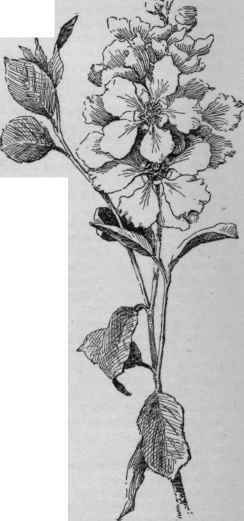Exochorda
Description
This section is from the book "The Standard Cyclopedia Of Horticulture Vol2", by L. H. Bailey. See also: Western Garden Book: More than 8,000 Plants - The Right Plants for Your Climate - Tips from Western Garden Experts.
Exochorda
(from exo, external, and chorde, a cord, referring to the chord belonging to the external part of the placenta on the ventral side of the carpels). Rosaceae. Pearl- Bush. Ornamental shrubs grown chiefly for the showy racemes of pure white flowers.
Deciduous: winter-buds conspicuous, with imbricate scales: leaves alternate, petioled, entire or serrate: flowers in terminal racemes, polygamo-dicecious; calyx-tube broadly turbinate; calyx-lobes and petals 5; stamens 15-25, at the margin of a large disk, short; carpels 5, connate; styles distinct: fruit a 5-angled, deeply furrowed caps., separating into 5 bony, 1-2-seeded carpels; seeds winged. - Three species in China and Turkestan.
The pearl-bushes are slender-branched shrubs with rather thin bright green foliage and very showy white flowers. E. Korolkowii is hardy North. E. racemosa and E. Giraldii are at least hardy as far north as Massachusetts. They grow best in a well-drained loamy soil and in a sunny position. Propagation is by seeds, or by softwood cuttings taken from forced plants; taken in summer from the open they root slowly and with difficulty; also by layering.
Racemosa
Rehd. (E. grandiflora, Lindl. Amelanchier racemosa, Lindl.). Fig. 1470. Slender spreading shrub, to 10, rarely to 15 ft., glabrous: leaves elliptic to elliptic-oblong or oblong-obovate, entire or on vigorous shoots serrate above the middle, 1 1/2- 2 1/2 in. long, whitish below; petioles about 1/2in.. long: racemes 6-10-flowered; flowers 2 in. across, pure white, short-stalked; petals roundish, clawed; stamens 15: fruit turbinate, about 1/2in. long. April, May. China. B.M. 4795. F. S. 9:954. L.I. 11-12. Gt. 47: 1455. R.H. 1889, p. 128; 1896, pp. 324, 325. J.H. III. 34:483; 53:285. G.C. II. 16:73; III. 7:613. Gn. 58, p. 315; 60, p. 232; 62, p. 161; 66, p. 141. A.F. 6:643. Gng. 5:97. F.E. 30:117; 31:971. G.M. 44:531. M.D.G. 1901:321; 1905: 254; 1906:561. G.W. 10, p. 430. H.F. 1867:250. variety prostrata, Hort. A form with prostrate branches. - The species is among the showiest shrubs blooming in May.
Giraldii, Hesse (E. racemosa variety Giraldii, Rehd.). Similar to the preceding: leaves oyal or elliptic, entire, very rarely cre-nate-serrate; petiole about 1 in. long, usually red: flowers very short-stalked or nearly sessile; petals obovate, gradually narrowed into the claw, sometimes toothed; stamens 25-30. N.W.China. M.D.G. 1909:295. G.W. 16, p. 450. variety Wilsonii, Rehd. (E. racemosa variety Wilsonii, Rehd.). Leaves elliptic to oblong, occasionally serrate; petioles 1/2-3/4 in. long, usually green: stamens 20-25. Cent. China.
Korplkowii, Lav. (E. Albertii, Regel. E. grandiflora variety Albertii, Aschers. & Graebn.,). Upright, slender-branched shrub, to 12 ft., glabrous: leaves oblong, to oblong-oblanceolate, obtuse or acute, gradually narrowed toward the base, entire, but the leaves of the stronger shoots often serrate above the middle and at the base with 1 or few small narrow lobes, 1 1/2-2 1/2 in. long: racemes 5-8-flowered; flowers 1 1/2 in. across; petals narrowly obovate; stamens 25: caps. 3/4in. long, ovoid, pointed. April, May. Turkestan. G.W. 16, p. 451. G. 31:505. - This is one of the earliest shrubs to burst into leaf in spring; it is of more upright habit and with darker and denser foliage than the preceding, but not so floriferous.

Fig. 1470. Exochorda racemosa. (X 1/3)
Macrantha
Lemoine (E. racemosa x E. Korolkowii). Similar to E. racemosa, but of more upright habit and more vigorous: leaves generally obovate or oblong-obovate, bright green, entire on vigorous shoots cre-nate, 2-3 in. long: racemes 8-10-flowered; flowers l 3/4-2 in. broad; petals obovate, narrowed into the claw; stamens about 20. April, May. Of garden origin. R.H. 1903, pp. 18, 64. M.D.G. 1902:484. G.W. 16:449.
Alfred Rehder.
Continue to:


